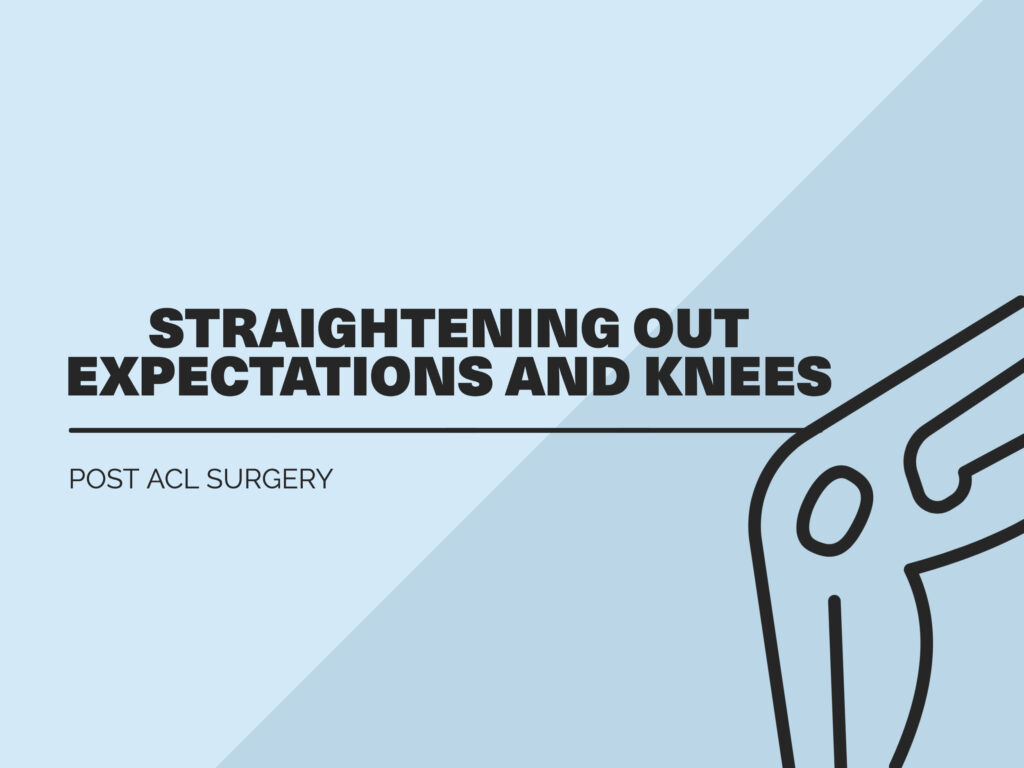
Tearing your Anterior Cruciate Ligament (ACL) in the knee generally leads to surgery within a month of the injury. The ACL is designed to assist with rotational stability and to prevent the bottom half of the leg (tibia) from shifting in front of the top half (femur). When that ligament is torn, the stability of the knee is greatly diminished, which can lead to further injury of the other ligaments and structures that make up the joint.
Knowing what to expect after surgery will help you to prepare and heal properly to avoid further complications. Enablr Therapy has great physical therapists that can help rehabilitate you after your ACL repair.
Goals of Rehabilitation Post-ACL Surgery
Pain and Swelling Management
Using ice and massage, you can decrease the fluid build up in the joint that causes increased stiffness and pain. Your orthopedic surgeon may prescribe a pain medication to use right after surgery. However, if the pain persists, over-the-counter anti-inflammatories can be used to manage the pain as well. Speak with your doctor if you experience increases in pain.
Full Range of Motion.
Initially, extension (straightening) of the leg is the main focus. The normal range of motion for extension of the knee is zero degrees. However, after surgery, the individual usually prefers a slight bend due to discomfort from swelling and pain. Laying flat on your stomach with your leg hanging off of a surface from the thigh down is a good exercise to improve full extension. Relaxing your leg as much as possible will allow your knee to straighten. Additional weight can be added as necessary. Stretching your hamstrings will also allow for improved extension.
Restoring full flexion (bending) of the knee is also very important for functional movements. The normal range for active flexion of the knee is 135 degrees. There are small milestones along the way. For example, to sit properly, you must have at least 90 degrees of flexion. To stand up from sitting properly, you must have at least 95-100 degrees of flexion. Your physical therapist will give you exercises to continue at home that can greatly improve your knee motion.

Quadricep Restoration.
At your first physical therapy appointment, you may notice that you cannot activate your quadriceps muscles in the front of the thigh on the injured leg. Restoring the use of the quadriceps is pertinent to improving stability of the knee and the ability to walk, balance, and return to prior level of function. All initial exercises will be incremental, sitting movements that focus on range of motion and quadricep activation. As that improves, standing exercises will be added and progressively get harder to further challenge the strength, endurance, and balance of the affected leg.
Kneecap Mobility.
The kneecap (patella) is often overlooked. However, you cannot successfully bend or straighten your knee without your kneecap gliding correctly with joint movement. With the knee straight and relaxed, the kneecap should glide freely. Improving the downward and upward movement will assist with improving range of motion.
Activity Engagement.
After your doctor has given you a status of full weight bearing on your affected leg, walking is a great way to improve your mobility and fluid movement through the joint. While walking, ensure you are using proper gait form by striking your heel down first and pushing off from your toe. Be sure to ice for 10 minutes a few times a day, depending on pain and swelling, and stretch before and after you walk or exercise.
As your mobility and strength returns in the affected leg, your Physical Therapist will then direct your goals to returning to prior activities. If you are an athlete, you will have agility and plyometric exercises. If you have more of a sedentary lifestyle, standing/walking endurance and balance will be within your goals. Be sure to have open communication with your therapist regarding your desired level of function.
If you have recently undergone surgery on your ACL, are soon to have surgery, or would like to address limitations from prior surgeries, view our physical therapy services page to see how Enablr Therapy’s physical therapists can help you!
References:
Colvin, D. (2018, October 13). ACL: 7 tips to make recovery from ACL surgery easier – Dr Colvin Perth. Shoulder and Knee Surgery Perth. Retrieved September 22, 2021, from https://www.shoulderandkneesurgery.com.au/7-tips-recovery-acl-reconstruction-surgery-easier-perth/.
Torn acl: Symptoms, diagnosis, and treatment options: Hss. Hospital for Special Surgery. (n.d.). Retrieved September 22, 2021, from https://www.hss.edu/condition-list_torn-acl.asp.


